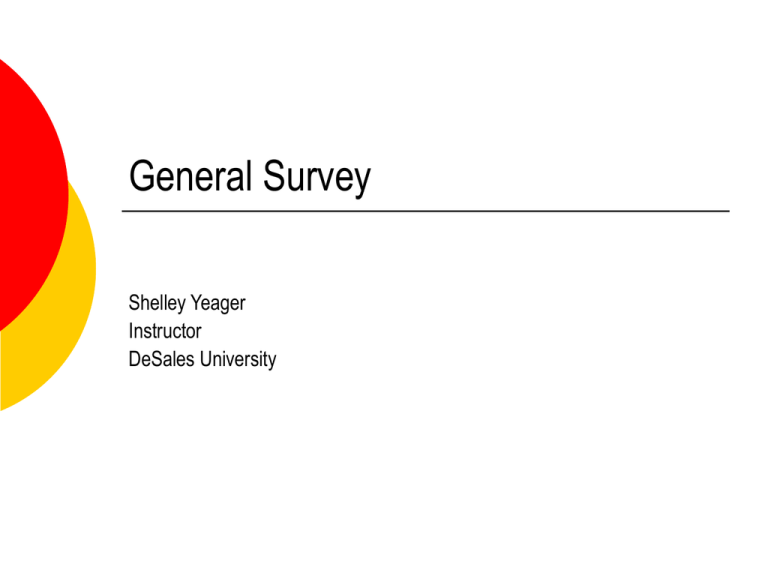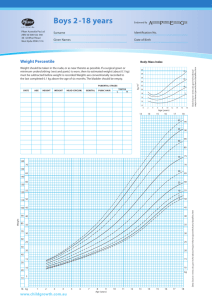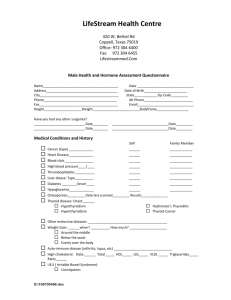General Survey - DeSales University WWW4 Server
advertisement

General Survey Shelley Yeager Instructor DeSales University Purposes of the General Survey To give an overall impression, a "gestalt", of the patient Techniques of Examination Age Technique: observe the patient from all angles Age (cont.) Normal findings: patient appears his/her stated age Age (cont.) Deviations from normal findings: patient's appears older than his/her stated age Sexual Development Technique: observe the female patient's breast and pubic hair development from all angles and observe the male patient's penis, testes, scrotum, and pubic hair development from all angles Sexual Development (cont.) Normal findings: Tanner’s stages of breast, penis and scrotum, and pubic hair development Tanner 1: Breast Development Preadolescent only the nipple is raised above the level of the breast, as in the child Tanner 2: Breast Development Budding stage Bud-shaped elevation of the areola Areola increased in diameter and surrounding area slightly elevated Tanner 3: Breast Development Breast and areola enlarged No contour separation Tanner 4: Breast Development Increasing fat deposits The aerola forms secondary elevation above that of the breast This secondary mound occurs in approximately half of all girls and in some cases persists in adulthood Tanner 5: Breast Development Adult stage The areola is (usually) part of the general breast contour and is strongly pigmented Nipple projects Tanner 1: Female Pubic Hair Development Preadolescent No growth of pubic hair Tanner 2: Female Pubic Hair Development Initial, scarcely pigmented straight hair, especially along the medial border of the labia Tanner 3: Female Pubic Hair Development Sparse, dark, visibly pigmented curly pubic hair on the labia Tanner 4: Female Pubic Hair Development Hair coarse and curly Abundant, but less than the adult Tanner 5: Female Pubic Hair Development Lateral spreading Type and triangle spread of adult hair to medial surface of the thighs Tanner 6: Female Pubic Hair Development Further extension laterally, upward, or dispersed (occurs in only 10% of women) Tanner 1: Penis and Scrotum Development Testes, scrotum, and penis are the same size and shape as in the young child Tanner 2: Penis and Scrotum Development Enlargement of the scrotum and testes The skin of the scrotum becomes redder, thinner, and wrinkled Penis no larger or scarcely so Tanner 3: Penis and Scrotum Development Enlargement of the penis, especially in length Further enlargement of the testes Descent of the testes into the scrotum Tanner 4: Penis and Scrotum Development Continued enlargement of the penis and sculpturing of the glans penis Increased pigmentation of the scrotum This stage is sometimes best described as "not quite adult" Tanner 5: Penis and Scrotum Development Adult stage Scrotum ample Penis reaching nearly to the bottom of the scrotum Tanner 1: Male Pubic Hair Development Preadolescent No growth of pubic hair That is, hair in pubic area no different from that on the rest of the abdomen Tanner 2: Male Pubic Hair Development Slightly pigmented, longer, straight hair Usually at the base of the penis Sometimes on the scrotum Tanner 3: Male Pubic Hair Development Dark, definitely pigmented, curly pubic hair around the base of the penis Tanner 4: Male Pubic Hair Development Pubic hair definitely adult in type but not in extent (no further than the inguinal fold) Tanner 5: Male Pubic Hair Development Adult distribution Hair spread to medial surface of thighs, but not upward Sexual Development Deviations from normal findings: precocious puberty delayed puberty Level of Consciousness Technique: observe the patient's response to external stimuli Level of Consciousness (cont.) Normal findings: patient responds immediately to minimal external stimuli Level of Consciousness (cont.) Deviations from normal findings: lethargic obtunded stuporous comatose Lethargic Definition patient appears drowsy, but opens his/her eyes and looks at you, respond to your questions, and then falls asleep Obtunded Definition patient opens his/her eyes and looks at you, but responds slowly to your questions and is somewhat confused alertness and interest in the environment are decreased Stuporous Definition patient arouses from sleep only after painful stimulus verbal responses are slow or even absent lapses into a unarousable state when the stimuli ceases minimal awareness of the self or the environment Comatose Definition patient remains unarousable with eyes closed there is no evident response to inner need or external stimuli Signs of Distress Technique: observe the patient for signs of distress Signs of Distress (cont.) Normal findings: no visible signs of distress Signs of Distress (cont.) Deviations from normal findings: signs of distress, e.g.: from cardiopulmonary insufficiency, e.g.: from pain, e.g.: labored breathing, shortness of breath, wheezing, cough wincing, sweating, holding painful part, protectiveness of painful part signs of anxiety, e.g.: anxious face; fidgety movements; cold, moist palms Stature Technique: observe the patient's stature from all angles Stature (cont.) Normal findings: height appears within normal range for age, genetic heritage Stature (cont.) Deviations from normal findings: height appears unusually tall for age, genetic heritage, e.g.: giantism acromegaly (hyerpituitarism) Marfan's syndrome height appears unusually short for age, genetic heritage, e.g.: Turner's syndrome achondroplastic dwarfism hypopituitary dwarfism Giantism Description excessive growth hormone secretion before closure of bone epiphyses in puberty causing overgrowth of all bones Acromegaly (Hyerpituitarism) Description excessive growth hormone secretion after closure of bone epiphyses in puberty causing overgrowth of the bones in the face, hands, and feet Marfan's Syndrome Description connective tissue disorder resulting in a tall, thin stature with long extremities and long, hyperextensible fingers Turner's Syndrome Description a chromosonal abnormality seen in about 1 in 3000 live female births, characterized by the absence of one X chromosone, congenital ovarian failure, genital hypoplasia, cardiovascular anomalies, short stature, short metacarpals, shield chest, underdeveloped breasts, uterus, and vagina Achondroplastic Dwarfism Description a genetic abnormality in the ability to convert cartilage to bone resulting in dwarfism characterized by a relatively large head, short stature, short limbs, thoracic kyphosis, prominent lumbar lordosis, and prominent abdominal protrusion Hypopituitary Dwarfism Description deficiency in growth hormone secretion in childhood characterized by a short stature Weight Technique: observe the patient's body weight from all angles Weight (cont.) Normal findings: weight appears within range for height and body stature body fat distribution is even Weight (cont.) Deviations from normal findings: • • • cachetic exogenous obesity excessive caloric intake • • • e.g., simple obesity even body fat distribution normal muscle strength endogenous obesity excessive secretion of or administration of adrenocorticotropic hormone (ACTH) • e.g., Cushing's syndrome • • • • • • • centripedal (truncal) obesity fat concentrated in the face, neck, trunk thin extremities decreased muscle strength due to muscle atrophy round (moon) face hirsutism purple abdominal striae (stretch marks) Body Symmetry Observe the patient's body symmetry from all angles Body Symmetry (cont.) Normal findings: symmetry in the size and shape of the body parts Body Symmetry (cont.) Deviations from normal findings: asymmetry in the size and shape of the body parts Posture Technique: observe the patient's posture from all angles Posture (cont.) Normal findings: patient stands comfortably erect as appropriate to age normal "plumb line" through anterior ear, shoulder, hip, patella, and ankle lordosis (sway back) and protruberant abdomen in standing toddler kyphosis (hunch back) in the aging person Posture (cont.) Deviations from normal findings: Position Technique: observe the patient's position from all angles Position (cont.) Normal findings: patient sits comfortably in a chair, on the bed, or on the examination table with arms relaxed at sides and head turned toward examiner Position (cont.) Deviations from normal findings: leaning forward with arms braced on chair arms (tripod position) sitting straight up and resisting lying down e.g., chronic pulmonary disease e.g., left-sided congestive heart failure curled up in a fetal position e.g., acute abdomen Body Build Technique: observe the patient's body build from all angles Body Build (cont.) Normal findings: arm span equals height body length from crown to pubis roughly equal to length from pubis to sole mesomorph ectomorph endomorph Mesomorph Description body build characterized by a predominance of muscle, bone, and connective tissue Ectomorph Description body build characterized by a slender and fragile physique Edomorph Description body build characterized by a soft, round physique with a large trunk and thighs, tapering extremities, and an accumulation of fat throughout the body Body Build (cont.) Deviations from normal findings: Marfan's syndrome Marfan’s Syndrome Description connective tissue disorder resulting in tall, thin stature with long extremities and long, hyperextensible fingers and an arm span that exceeds height and a pubis to sole measurement that exceeds crown to pubic measurement Gait Technique: observe the patient's gait from all angles Gait (cont.) Normal findings: normal pattern of gait gait of old age Normal Pattern of Gait Head is erect Gaze is straight ahead Vertebral column is upright Feet are a shoulder's width apart Heel strikes the ground before the toe Feet are dorsiflexed in the swing phase Normal Pattern of Gait Arm opposite the swingthrough foot moves forward at the same time Gait is smooth, coordinated, and rhythmic with even weight borne on each foot Gait (cont.) Deviations from normal findings: abnormal patterns of gait, e.g.: spastic hemiparesis scissors steppage sensory ataxia cerebellar ataxia Parkinsonian gait of old age Spastic Hemiparesis Associated with corticospinal tract disease, such as with cerebral vascular accident (CVA) Spastic Hemiparesis (cont.) One arm is held immobile and close to the side, with elbow, wrist, and interphalangeal joints flexed; the leg is extended, with plantar flexion of the foot; on walking, the patient either drags the foot, often scraping the toe, or circles it stiffly outward and forward (circumduction) Scissors Associated with bilateral spastic paresis of the legs Scissors (cont.) The gait is stiff; each leg is advanced slowly, and the thighs tend to cross forward on each other at each step; the steps are short; the patient appears to be walking through water Steppage Associated with foot drop, usually secondary to lower motor neuron disease Steppage (cont.) The patient either drags his/her feet or lifts them high, with knees flexed, and brings them down with a slap onto the floor, thus appearing to the walking up stairs; the patient is unable to walk on his/her heels; the steppage gait may involve one or both sides Sensory Ataxia Associated with the loss of position sense in the legs, as from polyneuropathy or posterior column damage Sensory Ataxia (cont.) The gait is unsteady and wide based (with feet wide apart); the patient throws his/her feet forward and outward and brings them down, first on the heels and then on the toes, with a double tapping sound; the patient watches the ground for guidance while walking; with the eyes closed, the patient cannot stand steadily with feet together (a positive Romberg sign) and the staggering gait worsens Cerebellar Ataxia Associated with disease of the cerebellum or associated tracts Cerebellar Ataxia (cont.) The gait is staggering, unsteady, and wide based, with exaggerated difficulty on turns; these patients cannot stand steadily with their feet together, whether their eyes are open or closed Parkinsonian Associated with the basal ganglia defects of Parkinson's disease Parkinsonian (cont.) The posture is stooped, with the head and neck forward and hips and knees slightly flexed; the arms are flexed at the elbows and wrists; the patient is slow getting started; steps are short and often shuffling; arm swings are decreased and the patient turns around stiffly "all in one piece" Gait of Old Age The aging process Gait of Old Age (cont.) Speed, balance, and grace decrease with aging; steps become short, uncertain, and even shuffling; the legs may be flexed at the hips and knees; a cane may bolster lost confidence Involuntary Movements Technique: observe the patient for involuntary movements from all angles Involuntary Movements (cont.) Normal findings: absence of involuntary movements Involuntary Movements (cont.) Deviations from normal findings: tics tremors seizures Facial Expression Technique: observe the patient's facial expression from all angles Facial Expression (cont.) Normal findings: maintains eye contact (unless a cultural taboo) expressions are appropriate to the situation Facial Expression (cont.) Deviations from normal findings: flat depressed angry sad anxious Mood and Affect Technique: observe the patient's mood and affect from all angles Mood and Affect (cont.) Normal findings: comfortable and cooperative with the examiner Mood and Affect (cont.) Deviations from normal findings: hostile distrustful suspicious crying Speech Normal findings: articulation is clear and understandable stream of talking is fluent with an even pace conveys ideas clearly word choice is appropriate to culture and education communicates in prevailing language easily by him/herself or with an interpreter Speech (cont.) Deviations from normal findings: • • • • • • dysarthria dysphagia speech defect monotone garbled speech extremes of few word or constant talking Dress Technique: observe the patient's dress from all angles Dress (cont.) Normal findings: well fitting clothes clothes look clean clothes are appropriate for the season and temperature clothes are appropriate to the person's culture and age group Dress (cont.) Deviations from normal findings: ill fitting clothes clothes look unclean clothes are inappropriate for the season and temperature consistent wearing of certain clothes, e.g.: long sleeves to cover needle marks of drug abuse Grooming and Personal Hygiene Technique: observe the patient's grooming and personal hygiene from all angles Grooming and Personal Hygiene (cont.) Normal findings: clothes shoes intact laces tied clothes are appropriate for age, occupation, and socioeconomic group hair clothes look clean clothes are properly buttoned and zipped clean groomed nails clean groomed Grooming and Personal Hygiene (cont.) Deviations from normal findings: clothes shoes have holes laces untied wearing slippers clothes are inappropriate for age, occupation, and socioeconomic group hair clothes look unclean clothes are improperly buttoned and zipped unclean poorly groomed nails unclean poorly groomed Odors of Body or Breath Normal findings: • absence of odors of the body and breath Odors of Body or Breath (cont.) Deviations from normal findings: • • • foul breath alcohol on the breath body odor





